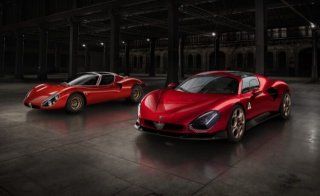- The Alfa Romeo 33 Stradale makes its debut at an international motor show, the 40th international exhibition of the Heritage “Auto Moto D’Epoca”, in its new location in Bologna.
- The 33 Stradale is patron of the “Alfa Romeo Classiche” services. Each of the 33 cars is a unique work of art, to be endorsed as such with a veritable birth certificate: the Certificate of Authenticity.
- The 33 Stradale will be introduced by its creators on Thursday, October 26th at 2:30 p.m. at the Stellantis Heritage Stand 25.
- To mark the occasion, Alfa Romeo is celebrating 60 years of the Giulia Sprint GT (1963) – 30 years of the glorious 155 V6 Ti “DTM” (1993) and 10 years of the fascinating 4C (2013).
- The “Alfa Romeo Classiche” Heritage program was set up in close collaboration with the Stellantis Heritage department and has devised specific services to protect and enhance its history.
Alfa Romeo 33 Stradale
The 40th edition of “Auto e Moto d’Epoca” is one of the major events in Europe for aficionados of vintage cars and motorbikes. It is Alfa Romeo’s first opportunity to reveal the Alfa Romeo 33 Stradale at an automobile exhibition as the honorary patron of the “Alfa Romeo Classiche” heritage program, a range of services with the clear objective of protecting and promoting the history of the iconic Italian brand.
With a limited run of 33 unique cars, one-off works of art. Guaranteed by its “CERTIFICATE OF AUTHENTICITY”
Inspired directly by the Tipo 33, a star #of global motorsport, the 1967 33 Stradale is believed by many to be one of the most beautiful cars ever. The new 33 Stradale is a scrupulous and respectful modern take on the stylistic features of its forerunner and takes center stage in Alfa Romeo’s manifesto to anticipate some of the brand’s future lines. With a run of just 33 cars, all already snapped up, it has been handcrafted in collaboration with Carrozzeria Touring Superleggera, a coachbuilder with top-quality, tailor-made standards that guarantee an obsessive attention to detail.
Each of the 33 vehicles is designed to be a unique, one-off work of art, thanks to an unprecedented level of customization. The “Bottega” team of Alfa Romeo professionals has been created to guarantee the uniqueness of each unit and it has involved its customers in the project from the very beginning to create their very own vehicle with their own unique features and even with the chance to “sign” the frame number.
To officially endorse their uniqueness, each 33 Stradale will have a Certification of Authenticity, further evidence of its absolute originality and exclusivity guaranteed by the manufacturer. A service that all owners of historic Alfa Romeo cars can benefit from to enhance their own vehicle.
the “Alfa Romeo Classiche” Heritage program features a range of services with the clear objective of protecting and promoting the history of the iconic Italian brand. The brand’s top management is personally involved in all the activities included in the entire range of dedicated services. Indeed, the certification committee is chaired by the Alfa Romeo CEO and by the Head of the Heritage Department, supported by the Alfa Romeo Museum, which houses the production records and all the technical documentation used by the committee to analyze the details of the vehicles under examination.
The Alfa Romeo Classiche Heritage program consists of the Certificate of Origin – available for Alfa Romeo vehicles since 2016 – together with the Certificate of Authenticity and the Restoration Service.
Certificate of Origin: Alfa Romeo offers the opportunity to discover the history of every vehicle via the chassis number. The service includes meticulous documentary verification using the brand’s production records and the issue of a certificate, which guarantees the year of manufacture and the car’s original configuration: model specifications, engine serial number, original internal and external details.
“Certificate of Authenticity”: After close analysis, the historic vehicle is examined and once the production details and technical specifications have been verified in the corporate archives, Alfa Romeo is supported by the heritage department to certify the authenticity of the vintage car. In order to obtain this certification, each car goes through a rigorous inspection and evaluation process, carried out by the specialist team that carefully checks its authenticity and its components, and the functioning of the main mechanical parts. The vehicle is examined in the Mirafiori Officine Classiche workshops, at the customer’s home if preferred, or at the Stellantis &You centers in Rome and Palermo.
“Restoration Service”: the same team that cares for the Alfa Romeo vintage collection is also available to private customers, with services ranging from simple maintenance to comprehensive restoration: from diagnosis and exterior restoration to repairs of individual mechanical and aesthetic components, all the way to final testing.
To find out more about all the Alfa Romeo Classiche services, visit the Heritage website.
The Bologna Motor Show is an opportunity for Alfa Romeo to celebrate major anniversaries
Sixty years of the Alfa Romeo Giulia Sprint GT (1963)
Introduced on September 9th, 1963, the Alfa Romeo Giulia Sport GT is now 60 years old and stands out for being the first vehicle manufactured – and “unveiled” – in the brand-new Arese plant, built to replace the original factory in Milan’s Portello district. The same year saw the creation of Autodelta, which became Alfa Romeo’s new Racing Department, marking the official return to competitions of the Biscione brand.
The Giulia Sprint GT replaced the Giulietta and was introduced as a coupé designed by Bertone (it was actually created by Giugiaro, a young employee of the Turin coachbuilder). It was equipped with the Giulia’s 1.6 engine (1,570 cc) with a light alloy twin camshaft, followed by a 1.3 (1,290 cc, “GT 1300 Junior”), then by a 1,750 (1,779 cc, “1750 GT Veloce”) and lastly by the 2-liter (1,962 cc, “2000 GT Veloce”).
The 4-seater with a clean, compact line featured round headlights with aggressive eyebrows and, what’s more, the typical “front lip” of the bonnet, a design element that disappeared as the model evolved its design. The Giulia GT lived up to the expectations of a sportier clientele: as in all Alfa Romeo vehicles, performance was top-quality with excellent driver handling and road holding.
The model exhibited in Bologna is a 1967 “GT 1300 Junior”, which was awarded a Certificate of Authenticity after a close examination by the FCA Heritage experts.
30 years of the Alfa Romeo 155 V6 Ti “DTM” (1993)
The Alfa Romeo 155 V6 Ti “DTM” entered into the seemingly never-ending sports competition between Italy and Germany, which began with the semi-final of the 1970 Football World Cup. This is why it was exactly 30 years ago that Alfa Romeo became the only non-German brand to win the DTM Championship.
In 1993, the Alfa Corse, the sports department of the Alfa Romeo Casa del Biscione, intensified its efforts in the Tourism category by introducing different evolutionary models of the Alfa 155: a very exaggerated one for the German championship, the other compliant with the less permissive rules of the new, international “D2” category. The 155 V6 TI developed for DTM (Deutsche Tourenwagen Meisterschaft) kept the four-wheel drive like the 1992 155 GTA (SuperTurismo Italiano). However, the mechanical layout was produced within the restrictions set by the rules of the German Championship: the engine – the famous 24-valve 2.5-liter V6-60° (2,498 cc) – was longitudinally installed as a counterbalance, with some of the bodywork components made of carbon fiber. The aerodynamics were “free” beneath the imaginary perimeter line connecting the wheel hubs, the rear wing was regulated and the road weight was 1,100 kg.
In 1993, the V6 ranged in power from 400 to 420 hp at 11,500 rpm, the engine and vehicle electronics were not exaggerated, and the six-speed gearbox became sequential halfway through the season.
During the race, the experienced competition was beaten in 12 of the 20 races scheduled, thanks to the invincible pairing of, Alessandro Nannini and Nicola Larini, who won the championship, not forgetting the contribution of the brilliant rankings of Francia and Danner.
10 years of the Alfa Romeo 4C (2013-2023)
Since its launch in 2013, the Alfa Romeo 4C has won the hearts of sports car enthusiasts the world over. To celebrate its 10th anniversary, the Heritage Department has designed a unique specimen of this mechanical gem: the “Alfa Romeo 4C Designer’s Cut”. Customized by Alessandro Maccolini at the Alfa Romeo Centro Stile (who also designed the model), this car pays tribute to the authentic Italian style and driving pleasure embodied by the original 4C, named by the same designer as “4C Unica”.
The 4C Designer’s Cut project forms part of the Heritage “Reloaded by Creators” program and has engaged the Alfa Romeo community, by inviting enthusiasts to choose from the aesthetic proposals made by Maccolini, via the brand’s communication channels.
The one-off 4C Designer’s Cut will be available for sale, enabling passionate collectors to purchase an important piece in the history of this iconic model, which remains to this day an “instant classic” on the market.



